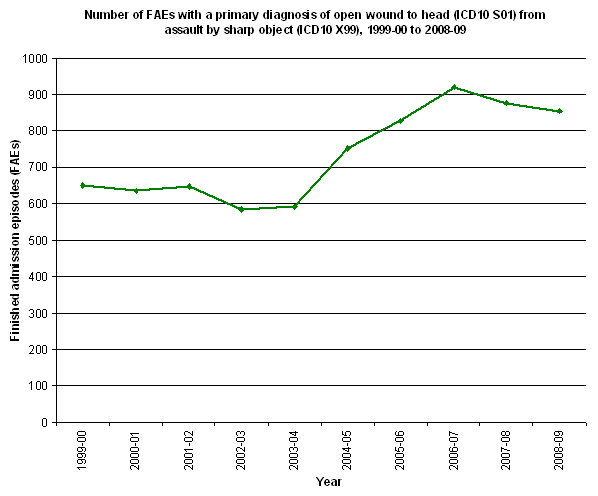IN THIS SITE...

External Causes
External cause codes are secondary diagnosis codes that reflect the cause of a patient's attendance in hospital. For example, the external cause code can tell us if the injury the patient was admitted for was from a transport accident or from an assault.
External cause of injury codes define both the manner of the death or injury and the mechanism. For example:
- manner: unintentional/self-inflicted/ assault/undetermined, etc
- mechanism: fall/exposure to, etc
External cause of injury codes can help us to:
- describe the magnitude of injury/morbidity by cause of injury
- identify population subgroups at high risk for a particular cause of injury, eg bicycle-related injuries in children aged 5-14 years
- identify specific high-incidence causes of injury in certain geographic locations, eg scald burns among 3-year-old children living in an inner-city area.
Examples of HES external cause codes data show that in 2008-09:
- there were 83,762 finished admission episodes (FAEs) for a fall on same level from slipping, tripping or stumbling (W01)
- there were 49 FAEs for exposure to sunlight (X32)
- there were 3,556 FAEs for striking against or struck by sports equipment (W21)
- there were 662 FAEs for contact with tap water (X11)
- there were 6 FAEs for bitten or struck by crocodile or alligator (W58)
- there were 59 FAEs for victims of lightening (X33).
 |
Data quality
Although this is a useful field within inpatients, the data coverage is low. In 2008-09, out of the 14.2 million records submitted to the Secondary Uses Service (SUS), only 1.1 million have a valid cause code attached, which shows limitations to the dataset. Since 2005-06 the proportion of unknown cause codes submitted has been around 92%.
Background
An external cause code should be sequenced following the related injury or poisoning code, or following the group of codes if more than one injury or condition has resulted from this external cause. External cause codes are recorded in the 19 secondary diagnosis fields (there were 13 prior to 2007-08 and 7 prior to 2002-03), which make it possible to record additional information in the episode. The most common cause codes cover accidents and poisoning.
Codes and values
These are ICD-10 codes in the range V01 to Y98:
- V01-V99: transport accidents
- W00-X59: other external causes of accidental injury
- X60-X84: intentional self-harm
- X85-Y09: assault
- Y10-Y34: event of undetermined intent
- Y35-Y36: legal intervention and operations of war
- Y40-Y84: complications of medical and surgical care
- Y85-Y89: sequelae of external causes of morbidity and mortality
- Y90-Y98: supplementary factors related to causes of morbidity and mortality classified elsewhere
Diagnosis codes are taken from the International Classification of Diseases and Health Related Problems, tenth revision (ICD-10). For further information on external cause codes refer to the World Health Organization's ICD-10 online.

